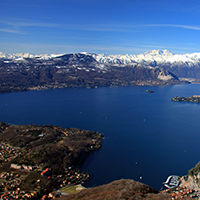Transparent exopolymer particles (TEP), phytoplankton and picocyanobacteria along a littoral-to-pelagic depth-gradient in a large subalpine lake

Submitted: 12 April 2021
Accepted: 15 May 2021
Published: 13 July 2021
Accepted: 15 May 2021
Abstract Views: 998
PDF: 234
Supplementary: 65
HTML: 61
Supplementary: 65
HTML: 61
Publisher's note
All claims expressed in this article are solely those of the authors and do not necessarily represent those of their affiliated organizations, or those of the publisher, the editors and the reviewers. Any product that may be evaluated in this article or claim that may be made by its manufacturer is not guaranteed or endorsed by the publisher.
All claims expressed in this article are solely those of the authors and do not necessarily represent those of their affiliated organizations, or those of the publisher, the editors and the reviewers. Any product that may be evaluated in this article or claim that may be made by its manufacturer is not guaranteed or endorsed by the publisher.
Similar Articles
- Florian Haupt, Maria Stockenreiter, Maarten Boersma, Herwig Stibor, Initial size structure of natural phytoplankton communities determines the response to Daphnia diel vertical migration , Journal of Limnology: Vol. 71 No. 1 (2012)
- Roberta Piscia, Norman D. Yan, Marina M. Manca, Mechanisms underlying recovery of zooplankton in Lake Orta after liming , Journal of Limnology: Vol. 75 No. s2 (2016): Lake Orta: a new lease on life
- Vincent Berthon, Aldo Marchetto, Frédéric Rimet, Emmanuelle Dormia, Jean-Philippe Jenny, Cécile Pignol, Marie-Elodie Perga, Trophic history of French sub-alpine lakes over the last ~150 years: phosphorus reconstruction and assessment of taphonomic biases , Journal of Limnology: Vol. 72 No. 3 (2013)
- Franco Tassi, Jacopo Cabassi, Dmitri Rouwet, Roberto Palozzi, Massimiliano Marcelli, Marco Quartararo, Francesco Capecchiacci, Matteo Nocentini, Orlando Vaselli, Water and dissolved gas geochemistry of the monomictic Paterno sinkhole (central Italy) , Journal of Limnology: Vol. 71 No. 2 (2012)
- Luigi Hinegk, Luca Adami, Sebastiano Piccolroaz, Marina Amadori, Marcello Moretti, Marco Tubino, Marco Toffolon, Multidecadal analysis of Lake Garda water balance , Journal of Limnology: Vol. 82 (2023)
- Pol Tarrats, Miguel Cañedo-Argüelles, Maria Rieradevall, Narcís Prat, Chironomid communities as indicators of local and global changes in an oligotrophic high mountain lake (Enol Lake, Northwestern Spain) , Journal of Limnology: Vol. 76 No. 2 (2017)
- Małgorzata Adamczuk, Spatial distribution of juvenile and adult stages of limnetic Cladocera in relation to selected environmental factors , Journal of Limnology: Vol. 71 No. 1 (2012)
- Javier Alcocer, Ana C. Ruiz-Fernández, Elva Escobar, Libia H. Pérez-Bernal, Luis A. Oseguera, Vilma Ardiles-Gloria, Deposition, burial and sequestration of carbon in an oligotrophic, tropical lake , Journal of Limnology: Vol. 73 No. 2 (2014)
- Fabien Bourinet, Orlane Anneville, Hilaire Drouineau, Chloé Goulon, Jean Guillard, Alexandre Richard, Synchrony in whitefish stock dynamics: disentangling the effects of local drivers and climate , Journal of Limnology: Vol. 82 (2023)
- Sanna T. Korkonen, Antti E.K. Ojala, Emilia Kosonen, Jan Weckström, Seasonality of chrysophyte cyst and diatom assemblages in varved Lake Nautajärvi – implications for palaeolimnological studies , Journal of Limnology: Vol. 76 No. 2 (2017)
<< < 1 2 3 4 5 6 7 8 9 10 > >>
You may also start an advanced similarity search for this article.

 https://doi.org/10.4081/jlimnol.2021.2021
https://doi.org/10.4081/jlimnol.2021.2021






